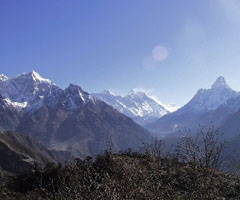
» Ville fjell og vennlige mennesker
» Nepalsk ornitolog kikket pa Lista
» Namaste Nepal passer for reiseskildringer














&
Temparature
Crown of the World Experience Mountain View Trek & Tour
 Day 01: Arrival in Kathmandu
Day 01: Arrival in Kathmandu
meet and transfer to hotel and evening well come dinner.
The Kathmandu Valley has an exotic setting. It is surrounded by a tier of green mountain wall above which tower mighty snow-capped peaks. It consists of three main towns of great historic, artistic and culture interest: Kathmandu, Patan and Bhaktapur. The Kathmandu valley covers an area of 218 sq. miles. It is situated 4223 ft. above sea-level
Day 02: Full day sightseeing in Kathmandu valley.
Swoyambhunath. The history of the Valley, according to the legends, begins with Swoyambhu, or the “the self-existent”. In times uncharted by history, Bodhisattva Manjusri came across a beautiful lake during his travel. He saw a lotus that emitted brilliant light at the lake’s center, so he cut a gorge in a southern hill and drained the waters to worship the lotus. Men called it the Kathmandu Valley. From then on, the hilltop of the Self-existent Lord has been a holy place.
Pashupatinath
One-day lord Shiva got tired of this glittering palace on Mt. Kailash, his armies of ghosts and spirits, and even Parbati – his beautiful wife. Through his cosmic powers, he searched for a perfect place where he could holiday. Without telling anyone, he ran away from his palace and came to live in Slesmantak forest in the Kathmandu valley. He gained great fame here as Pashupati – Lord of the Animals – before other gods discovered his hiding place and came to fetch him. The Pashupati where he stayed has received the attention of worshippers for at least fifteen hundred years; it is the holiest Hindu pilgrimage destination in Nepal
Bouddhanath
Bouddhanath is among the largest stupa in south Asia, and it has become the focal point of Tibetan Buddhism in Nepal. The white mound looms thirty-six meters overhead. The stupa is located on the ancient trade route to Tibet, and Tibetan merchants rested and offered prayers here for many centuries. When refugees entered Nepal from Tibet in the 1950s, many of them decided to live around Bouddhanath. They established many gompas, and the “Lit the Tibet” of Nepal was born. This “Little Tibet” is still the best place in the valley to observe Tibetan lifestyle. Monks walk about in maroon robes. Tibetans walk with prayer wheels in their hands and the rituals of prostration are presented to the Buddha as worshippers circumambulate the stupa on their hands and knees, bowing down to their lord.
Kathmandu Durbar Square
It is easy to be overwhelmed by the seemingly uncountable monuments in the Kathmandu Durbar Square. The house of the Living goddess, the ferocious Kal Bhairab, the red monkey god, and hundreds of erotic carvings are a few examples of the sights at the square! The building here is the greatest achievements of the Malla dynasty, and they resulted from the great rivalry between the three palaces of Kathmandu, Patan and Bhaktapur. The valley was divided among the children of Yaksya Malla. For visitors today, and for the Nepalese, it was serendipitous that they, and later their off springs, began artistic warfare trying to outdo each other in splendid constructions. Kings copied every thing their neighbors built in an even grander style. A visitor who wanders around the Square will see a round temple in the Pagoda architectural style, the temple of goddess Taleju (who played dice with King Jaya Prakash Malla), and an image of Shiva and Parbati sitting together among the many monuments.
Day 03 After breakfast drive to Pokhara overnight at hotel
Pokhara is a place of remarkable natural beauty. The serenity of Phewa Lake and the magnificence of the fish-tailed summit of Machhapuchhre (6,977m) rising behind it create an ambiance of peace and magic. At an elevation lower than Kathmandu, it has a
Much more tropical feel to it, a fact well appreciated by the beautiful diversity of flowers which prosper in its environs. Indeed, the valley surrounding Pokhara is home
to thick forests, gushing rivers, emerald lakes, and of course, the world Famous views of the Himalaya. Clearly the most the most stunning of Pokhara's sights in the spectacular panorama of the Annapurna range which forms its drop. Stretching from east to west, the Annapurna massif includes Annapurna I to IV and Annapurna South.
Everest View Trek
Whilst for many a visit to the foot of Mount Everest is a personal goal, for some it is enough to visit the Everest or Khumbu region and experience the culture, the people, and the spectacular scenery. The Everest View trek is a shorter trek than the Base Camp trek with the famous Tengpoche monastery at 3870m being the high point. It is designed for those who wish to experience this region without ascending to high altitude. Entry to the Khumbu is by air into the airstrip at Lukla, and from here we follow the route of the Base Camp trek to Tengpoche monastery. From here we obtain breathtaking views of Everest as it rises above the Lhotse-Nuptse ridge, as well as a superb view of one of Nepal's most beautiful mountains, Ama Dablam - the 'Matterhorn of the Khumbu'. From here we return to Lukla by a slightly different route via Khumjung. This is a short but classic trek, which allows access to the most spectacular mountain views in the world, in a shorter time frame. Accommodation and food is provided in the local teahouses.
Itinerary
Day 04 Fly Kathmandu to Lukla, trek to Phakding
After a very early start, and an early take off from Kathmandu Domestic Airport, a 45 minute flight is all it takes to propel us into the Everest region of Nepal. The landing at Lukla (2800m) is spectacular and on arrival we are greeted by our sirdar and trekking crew who organise the luggage and hustle us off for tea. After a leisurely lunch we start the trek in earnest, setting off for a gentle walk to Phakding (2800m), a further 3 hours to the north. The trail leads through Lukla, past hotels, shops and airline offices to the edge of the Lukla plateau where the trail drops to meet the intersection of the Jiri trail at Chablung. From here the trail follows the Dudh Koshi north through the village of Ghat and then finally to Phakding where we spend the night.
Day 05 Phakding to Namche Bazaar
From Phakding the trail continues north up the Dudh Koshi Valley, staying 100m above the river on it's west bank. The trail leads us to Jorsale (2810m) where we enter the Sagarmatha National Park, and submit our trekking permits for checking. From here we continue on an ever-sweetening trail to Namche Bazaar (3440m), known simply as Namche. En route we cross the spectacular suspension bridge high above the confluence of the Bhote Koshi and the Dudh Koshi, and shortly after glimpse our first view of Everest, way off to the north-east. The trail to Namche is steep and long, but eventually we reach the remarkable Sherpa capital perched high on the hillside and dominated to the east by the immense bulk of Kwangde (6187m).
Day 06 Namche to Tengpoche
From Namche we trek north-east on a direct line to Everest, starting up the hill to the Visitor Centre and Continuing on a reasonably flat easy trail high above the Dudh Koshi. Ahead of us we can see one of the most beautiful mountains in the Khumbu - Ama Dablam (6856m), as well as Everest still far off in the distance. We pass through the settlement of Sanasa before making our descent to the Dudh and Koshi the village of Phunki Thanga. Of course, 'what goes down must go up', and from here it is a steep long climb up the side of the hill to the saddle on which Tengpoche Monastery is located at 3870m. As we enter the grounds of Monastery we will be welcomed by the most magnificent Mountain View in the world. The long climb seems well worth it as we gaze upon a panorama of Himalayan giants, including Everest as it peeks above the Lhotse-Nuptse ridge.
Day 07 Tengpoche to Khumjung
From Tengpoche the trail drops steeply to the river at Phunki Thanga, and then rises again to traverse high above the river on the winding trail leading back to Namche Bazaar. Shortly after passing through Sanasa, we branch off to the right and take the trail leading gradually upwards to the extensive Sherpa settlement of Khumjung at 3790m. Khumjung is the the largest village in the Khumbu and contains many items of interest for the visitor – the Gompa possesses the supposed skull of a Yeti but this has been scientifically disproved. Also in Khumjung is the Hillary School, and further up the hill at the village of Khunde is the Khunde Hospital, built in 1966 and maintained by the Sir Edmund Hillary Himalayan Trust. This is well worth a visit, and all donations of money or medical supplies are most welcome.
Day 08 Khumjung to Jorsale/ Manju
We complete our circular route by returning to Namche and from here continue on down the main Everest trail. This is a short day and hence we have time to browse the shops in Namche, before descending steeply to the river. The trail is easier now as we are losing altitude, and we can enjoy a gentle walk on the trail above the Dudh Koshi to Jorsale.
Day 09 Jorsale/ Manju to Lukla
The final day of our trek - we retrace our steps along the trail above the Dudh Koshi before turning off the main Jiri route and rising up to Lukla, where we arrive by mid-afternoon.
Day 10 Fly back from Lukla to Kathmandu.
Day 11 Drive from Kathmandu to Sauraha Chitwan and after lunch visiting the Tharu Village Visit and back to Lodge 7.00 p.m. dinner and over night lodge.
Day 12 After breakfast Canoe trip and Jungle walk and back to Camp. 12.45 p.m. Lunch
3.00 p.m. Elephant ride in the park about 1 hrs. 7.00 p.m. dinner and culture program
Day 13 Early morning Bird watching tour about 1½ hrs, And back to Camp then Break fast and 9.30 A.m. Departure to Kathmandu. Over night hotel.
Day 14 Final departure from Kathmandu.
The following information will allow you to better plan your budget for tours or treks. A range of costs is given. These costs are dependant on:- The mix of Touring and/or general Trekking,
- The remoteness of the areas visited,
- The number of guides or porters required,
- The standard of accommodation required (if there is a choice),
- The type of ground transport used,
- The length of your visit, and
- The size of your group.
Depending on group size the costs of treks and tours range from:
1 to 3 pax US$ 88 to 163 P/p per night.
4 to 8 pax US$ 78 to 148 P/p per night
9 to 14 pax. US$ 75 to 135 P/p per night.
15 to 20 and above US$ 60 to 110 P/p per night
Single supplement US$ 40 to 70 per night.
Note: The itinerary and cost for Peak climbing, Mountaineering, Tibet, Bhutan and India tours and trek are conditional apply.
Notwithstanding the costs shown above, we can tailor tours to suit almost any budget. Feel free to email us for more information.
Note: One tour leader will be free of cost for tours with 15 or more paying guests only.
Children's bellow three years is free if sharing with their parents. And need to pay if they are participating on the trekking, and above three to nine year children half of the price.
Cost Includes: Accommodation in 3 to 4 star hotels in the cites as your choice, basic accommodation in a lodge or tea house or camping (depending on your itinerary and choice) during treks, guides and porters on treks, all land transfers by private vehicle, 3 meals a day on treks, all jungle safaris, all sightseeing tours as per itinerary and all necessary entry fees, permits and airport transfers.
Cost Excludes: Personal expenses, domestic air tickets, airport tax, drinks (soft drink, mineral water and alcoholic beverages and hot-shower on the trek), personal insurance, and extra cost due to natural calamities or accidents outside of our control.
Please note that our guides speak the following English languages and if required we will provide your language spiking guide on extra cost.
Note: Please contact exploretrek@wlink.com.np for more information and prices
Translate
Contact Information:
Alpine Explore NepalP.O. Box: 4546, Kathmandu, Nepal
+977 1 4700714 / 4700175 / 4701974
Fax: +977 -1 - 4700970
Email: info@traveltrek.asia
sales@traveltrek.asia
Skype Address: explore.alpine
MSN Messanger: explorealpine
Yahoo Messanger:explorealpine

Unlimited Everest Rolwaling Trek with Panorama Views Amazing Annapurna Manang, Tilicho Lake and Thorangla-Pass Jomsom Manaslu and Annapurna Hidden Valley Trek, Manang Everest with High Pass Trekking Upper Mustang TrekWestern Nepal Dolpo Rara Lake Trek


Our Guest Says
SteveAnyon-Smith18 April 2000
This was my third trek in Nepal, having visited the Annapurna Region in 1995 and with Bharat and Dave in the beautiful and wildlife-filled Langstang Valley in1998. Bharat's company "Explore Alpine Adventure"....












